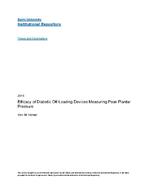|
|

Notes
- Abstract:
- Decreasing forefoot plantar pressure is an important factor in the prevention and treatment of diabetic ulcerations. Although offloading devices have been shown to mitigate plantar pressure, there is currently little research comparing the directly comparing the efficacy of these offloading devices. The purpose of this study was to compare the forefoot plantar pressure between four of the most commonly used off-loading devices (TCC EZ, Medi-Kast, BSN Cutimed cast systems, Extra-depth Diabetic Shoe [DS]). Twenty healthy participants’ forefoot plantar pressure was measured while walking in each device. One podiatrist applied the device around the Tekscan f-scan Versa Tek Wireless mapping plantar pressure sensor. Data collection was randomized between each device as plantar pressure was collected during a 3-minute walk on a treadmill at a pace of 1.8 mph. A Repeated Measures ANOVA was conducted to compare the peak pressures between each device. In this direct comparison of popular off-loading methods, all TCC devices significantly lowered peak forefoot plantar pressure as compared to the DS. Additionally, the peak plantar pressure in the TCCEZ and Cutimed casts was significantly lower than that of the Medicast, however, there was no difference in peak forefoot plantar pressure between the TCCEZ and Cutimed. Therefore, since there is a greater correlation in the reduction of peak forefoot pressure in these TCC devices compared to DS as well as the TCC devices compared to one another, we can begin to draw positive trends for best practice in the treatment of Diabetic Foot Ulcers.
- Thesis:
- Thesis (M.S.)--Barry University, 2015.
- Bibliography:
- Includes bibliographical references (leaves 53-59).
Record Information
- Source Institution:
- Barry University
- Holding Location:
- Barry University Archives and Special Collections
- Rights Management:
- Copyright Von M. Homer. Permission granted to Barry University to digitize, archive and distribute this item for non-profit research and educational purposes. Any reuse of this item in excess of fair use or other copyright exemptions requires permission of the copyright holder.
- Resource Identifier:
- RD563.H66 2015_HomerVon ( BU-Local )
- Classification:
- RD563.H66 2015 ( lcc )
|
|